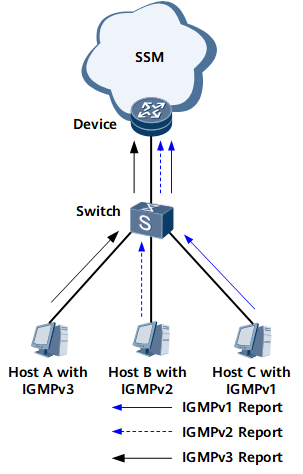Layer 2 SSM Mapping
Background
IGMPv3 supports source-specific multicast (SSM), but IGMPv1 and IGMPv2 do not. The majority of the latest multicast devices support IGMPv3, but most legacy multicast terminals only support IGMPv1 or IGMPv2. SSM mapping is a transition solution that provides SSM services for such legacy multicast terminals. Using rules that specify the mapping from a particular multicast group to a source-specific group, SSM mapping can convert IGMPv1 or IGMPv2 messages whose group addresses are within the SSM range to IGMPv3 messages. This mechanism allows hosts running IGMPv1 or IGMPv2 to access SSM services. SSM mapping allows IGMPv1 or IGMPv2 terminals to access only specific sources, thus minimizing the risks of attacks on multicast sources.
Layer 2 SSM mapping is used to implement SSM mapping on Layer 2 networks. For example, on the network shown in Figure 1, the Layer 3 device runs IGMPv3 and directly connects to a Layer 2 device. Host A runs IGMPv3, Host B runs IGMPv2, and Host C runs IGMPv1 on the Layer 2 network. If the IGMP versions of Host B and Host C cannot be upgraded to IGMPv3, Layer 2 SSM mapping needs to be configured on the Layer 2 device to provide SSM services for all hosts on the network segment.
Implementation
If SSM mapping is configured on a multicast device and mapping between group addresses and source addresses is configured, the multicast device will perform the following actions after receiving a (*, G) message from a host running IGMPv1 or IGMPv2:
- If the message's multicast group address is not in the SSM group address range, the device processes the message in the same manner as it processes an IGMPv1 or IGMPv2 message.
- If the message's multicast group address is in the SSM group address range, the device maps the (*, G) message into (S, G) messages based on mapping rules.
Deployment Scenarios
Layer 2 SSM mapping can be used on VLANs and VPLS networks.
Benefits
Layer 2 SSM mapping offers the following benefits:
- Enables IGMPv1/v2 terminal users to enjoy SSM services.
- Better protects multicast sources against attacks.
